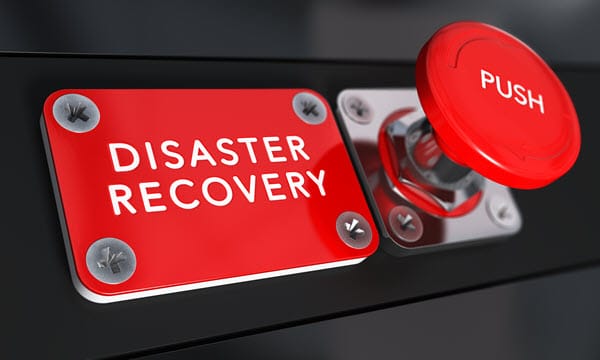
How important is a disaster recovery plan? According to FEMA, 40% of all businesses who experience a disaster never reopen their doors. And 25% of the ones that do fail within a year. Most every company today has a data footprint. That data needs to live somewhere and be protected. A documented disaster recovery plan is a lot like an insurance policy. You hope you never need it. But you are sure glad you have it when you do.
Most large companies have a disaster recovery plan in place. However, many small to mid-sized businesses either don’t have one or are operating with one that doesn’t provide the level of protection they need. There are many events that could put your data at risk, some more obvious than others. But each of them has the potential to cause problems. The most common risks to your data include:
- Human error
- Malicious employee behavior
- Hardware failure
- Natural disasters
- Power failure
- Ransomware
- Cybercrime
Regardless of the cause, disaster is a major threat to your data and business continuity. That’s why disaster recovery plans are so critical. Let’s explore the factors you need to consider when deciding on a solution and detail how Applied Technologies helps companies develop, implement, and test data recovery plans for long-term protection.
Weighing Your RPO and RTO
One of the most common hesitations businesses have with developing a disaster recovery plan is the cost. They struggle to prioritize budget for something they might never need. But there is a broad spectrum of disaster recovery solutions available on the market today. Compared to the data and financial loss they could incur in a disaster, a well-implemented plan would more than pay for itself if it were needed just once over the life of a business. And even if it’s never needed, the peace of mind that comes with having it takes one less stress off their shoulders so they can focus on running the business.
The extent of your disaster recovery plan and the cost associated with it are heavily weighted by two factors: your recovery point objective (RPO) and your recovery time objective (RTO). Your RPO is the point in history you need to go back to for data recovery. Your RTO is how quickly your business needs to be back up and functioning. While a financial institution might have very stringent needs for a long RPO and a quick RTO, a retail store might have more flexibility and the solution and cost would reflect that.
The Disaster Recovery Planning Process
Applied Technologies’ data recovery planning process starts with a complete assessment of your current infrastructure. We want to determine the amount of data you’re backing up, how long you need to retain that data, and how often you need to perform a backup. We’ll ask the right questions to help establish your RPO and RTO. Once we know what you need, we work with our technology partners to implement the right solution for your organization. We get your backups going on a recurring basis, document the plan including screenshots of what you would see in a disaster recovery situation, and set up a plan for annual testing. Technology is ever changing, and new challenges arise every day. In many cases, we serve as a long-term partner for customers, managing their annual testing.
Disasters do not discriminate, and they rarely happen at a time when it’s convenient for you. So we deliver your plan in both a hard copy version that can sit on a shelf in your server room, and a digital version you can store in a secure location. This ensures that even if key IT personnel are not present at the time of the disaster, there are step-by-step instructions for other employees to follow to recover the system.
Why We Partner with Veeam for Disaster Recovery
Veeam is a company we commonly partner with in the development of disaster recovery solutions for customers. They are a software company with a hardware-agnostic approach to disaster recovery. Their solutions work on whichever hardware and server products you choose to use.
One of the biggest things that sets Veeam apart is their Microsoft 365 backup solution. Many companies using Microsoft 365 believe their data is protected from disaster because it is a cloud-based solution. Unfortunately, we’ve met with companies who had to find out the hard way that wasn’t the case. For more information on the data that is and isn’t protected by Microsoft, and how Veeam provides protection and access for all your Microsoft 365 business data we suggest checking out their Veeam Backup for Microsoft 365 whitepaper.
Protect the Irreplaceable with Applied Technologies and Veeam
Operating a business with an inadequate plan (or no plan at all) for disaster recovery is gambling with incredibly high stakes. If this article has left you feeling unsure how prepared your business is for a disaster, contact Applied Technologies. We will provide an honest assessment of your current vulnerabilities and a clear plan for overcoming them with a carefully architected plan utilizing the latest in data recovery technology from Veeam and our other disaster recovery technology partners.